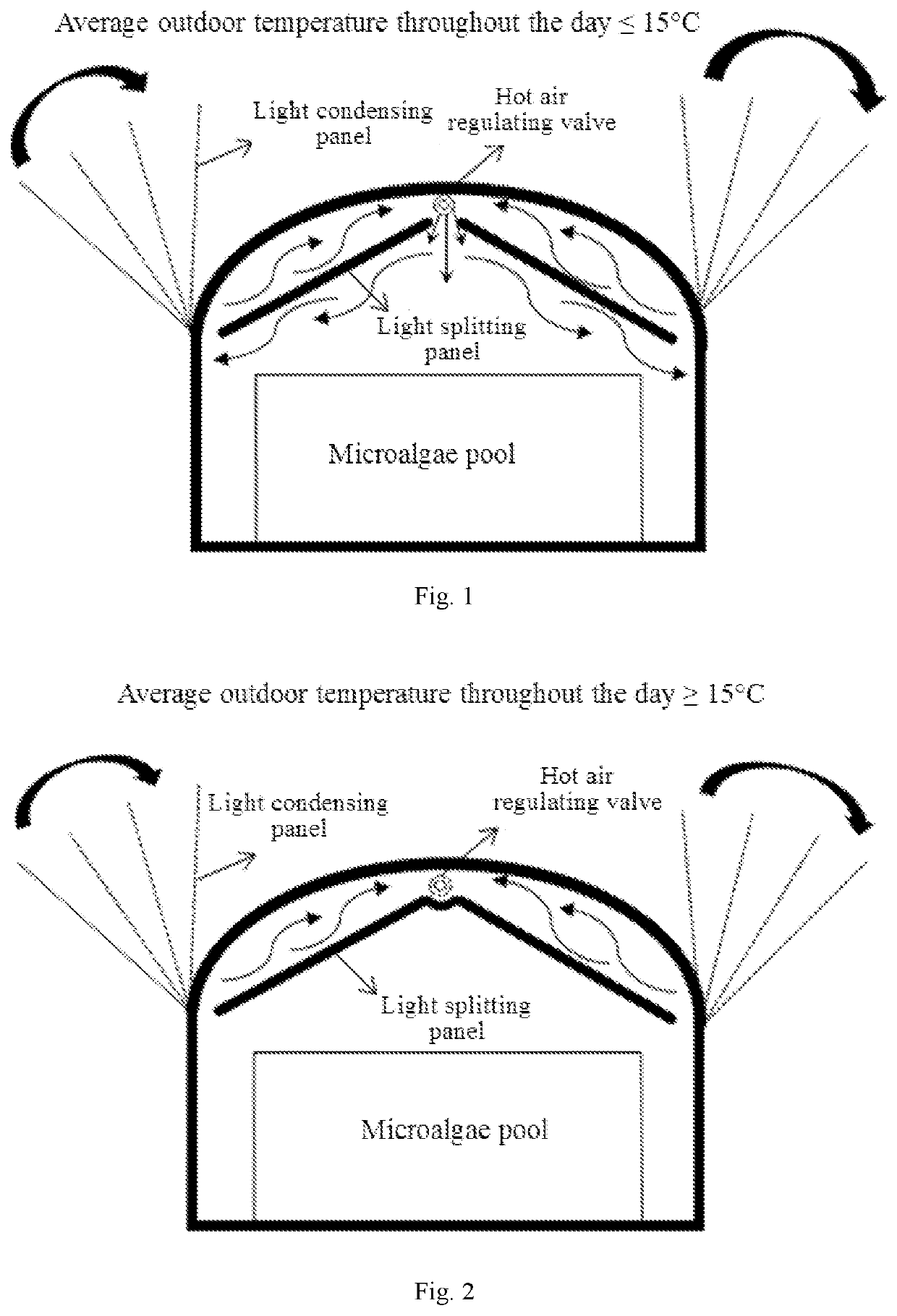System and Method for Microalgae Carbon Fixation Regulated Based on Natural Environmental Changes
a carbon fixation system and microalgae technology, applied in the field of system and a method for microalgae carbon fixation regulated based on natural environmental changes, can solve the problems of increasing exponential energy consumption of cosub>2 /sub>capture and purification, limited storage and use, and low long-distance utilization, etc., to reduce the amount of required cooling water, reduce the number of days of operation, and reduce the effect of coupling industrial production
- Summary
- Abstract
- Description
- Claims
- Application Information
AI Technical Summary
Benefits of technology
Problems solved by technology
Method used
Image
Examples
example 1
Method for Carbon Fixation by Spirulina Suitable for use in High-Irradiance and High-Temperature Natural Environmental Conditions
[0042]A light reflective film with a reflectance of 80%-90% was attached to a surface of a light-condensing reflective panel. An angle between incident sunlight and the light-condensing panel (i.e., the light-condensing reflective panel) was 35°-45°. A length ratio of the light-condensing panel to a microalgae pool was 1:1, and a width ratio of the light-condensing panel to the microalgae pool was 1:1.
[0043]Light splitting panels each adopted a light splitting film made of a glass substrate and a silicon substrate, which was a light splitting film with 30-35 layers of SiO2 / TiO2, with a transmittance of 0.85 for visible light within 300-700 nm, and a reflectivity greater or equal to 0.65 for infrared light within 700-2500 nm.
[0044]At a temperature higher than 25° C., a connecting panel between the light splitting panels was closed, and heated hot air flowed...
example 2
Method for Carbon Fixation by Spirulina Suitable for use in Low-Irradiance and Low-Temperature Natural Environmental Conditions
[0046]A light reflective film with a reflectance of 90% was attached to a surface of a light-condensing reflective panel. An angle between incident sunlight and the light-condensing panel (i.e., the light-condensing reflective panel) was 45°. A length ratio of the light-condensing panel to a microalgae pool was 1:1, and a width ratio of the light-condensing panel to the microalgae pool was 1.2:1. Light splitting panels each adopted a light splitting film made of a glass substrate and a silicon substrate, which was a light splitting film with 25-30 layers of SiO2 / TiO2, with a transmittance of 0.9 for visible light within 300-700 nm, and a reflectivity greater or equal to 0.5 for infrared light within 700-2500 nm. A hot air regulating valve was fully closed, and a connecting panel between the light splitting panels was opened. All hot air was used to circulate...
PUM
| Property | Measurement | Unit |
|---|---|---|
| temperature | aaaaa | aaaaa |
| temperature | aaaaa | aaaaa |
| wavelength | aaaaa | aaaaa |
Abstract
Description
Claims
Application Information
 Login to View More
Login to View More - R&D
- Intellectual Property
- Life Sciences
- Materials
- Tech Scout
- Unparalleled Data Quality
- Higher Quality Content
- 60% Fewer Hallucinations
Browse by: Latest US Patents, China's latest patents, Technical Efficacy Thesaurus, Application Domain, Technology Topic, Popular Technical Reports.
© 2025 PatSnap. All rights reserved.Legal|Privacy policy|Modern Slavery Act Transparency Statement|Sitemap|About US| Contact US: help@patsnap.com

